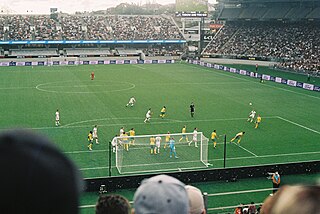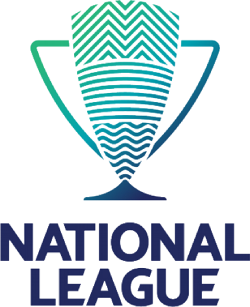
The Northern League is an amateur New Zealand association football competition. It is a top-tier competition during the winter season, and sits at step two overall.

The New Zealand Football Championship was a men's association football league at the top of the New Zealand league system. Founded in 2004, the New Zealand Football Championship was the successor to a myriad of short-lived football leagues in the country, including the National Soccer League, the National Summer Soccer League and the New Zealand Superclub League. The league was contested by ten teams in a franchise system. For sponsorship reasons, the competition was known as the ISPS Handa Men's Premiership. From the 2021 season, it was replaced by the New Zealand National League.

Cambridge F.C. is a football club based in Cambridge, New Zealand. It currently plays in the NRFL Southern Conference.

The Central League is an amateur status league run by Capital Football for association football clubs located in the southern and central parts of the North Island. It is a New Zealand top-tier competition during the winter season, and sits at step two overall under the summer National League.

Association football, also known as football or soccer, is a popular recreation sport in New Zealand. The sport is administered in New Zealand by the governing body New Zealand Football (NZF). It is the third-most popular men's team sport after rugby union and cricket.

The National League is the top-level women's football league in New Zealand. The teams were run by regional federations until 2021, when New Zealand Football started to move to club-based football.
Huntly Thistle are an association football club based in the New Zealand town of Huntly, in the northern Waikato region. The club currently have teams in the WaiBop Premiership, Senior Men's, Senior Women's, Juniors and WSSFA College. Earlier points in their history they were one of the stronger teams in the Waikato. The club played in the top flight of the Northern League in the early 1970s, and at that time contained the club's only full international player, Jim Moyes.
John Kerkhof Park is a venue for football (soccer) matches in Cambridge, New Zealand. It is the all-year home of Cambridge FC who compete in the Northern League.

The Kate Sheppard Cup, currently known as the New Zealand Football Foundation Kate Sheppard Cup for sponsorship purposes, is New Zealand's premier knockout tournament in women's association football. Founded in 1994, it was known as the Women's Knockout Cup, until it was renamed in 2018. What would have been the 2020 edition of the competition, was cancelled because of COVID-19 but the competition continued again in 2021.
The 2016 National Women's League was the fourteenth season of the NWL since its establishment in 2002. Seven teams were involved this season, after being in the competition the last few seasons as preparation for the FIFA U-17 Women's World Cup, the NZ Development Squad wasn't included in the league anymore.
The 2018 National Women's League was the sixteenth season of the NWL, New Zealand's top level women's football league since its establishment in 2002. Seven teams were again involved in this season representing the different regions in New Zealand. This was the first year that the league had two rounds with the two highest-placed sides progressing to a one-off grand final. The season also featured a double header round over Labour weekend, in which all sides except Capital played two matches over the weekend.
The National Youth League (NYL) is the premier competition for youth football players in New Zealand. Founded in 2003, it was a league competition consisting of the youth teams of each of the ten clubs that played in the New Zealand Football Championship. It was held each season between October and December, and consists of each team playing each other once; the fixture list mirrors that of the senior league.
The 2019 National Women's League was the seventeenth season of the NWL, New Zealand's top level women's football league since its establishment in 2002. Seven teams were involved in this season representing the different regions in New Zealand. This was the second year that the league played two rounds, with the two highest-placed sides progressing to a one-off grand final. The season also featured a double header round over Labour weekend, in which all sides except Central played two matches over the weekend.
The NRF League One is a New Zealand amateur football league. The league is run by Northern Region Football, an amalgamation of the Auckland Football Federation and Northern Football Federation, and includes football clubs located in Northland and Auckland. It comprises half of the fifth tier of football in the northern North Island, alongside the WaiBOP League One. Up until 2022, the competition was known as NRF Championship.
The 2020 Women's Premiership was the eighteenth season of the league, New Zealand's top level women's football league since its establishment in 2002. Seven teams again were involved in the season representing the different regions in New Zealand. The league after consultation and feedback from stakeholders, was reverted to a single round-robin format, with the two highest-placed sides progressing to a one-off grand final. Canterbury United Pride was again the team to beat, as they were looking at a threepeat, having played in every final since 2013, won five out of seven of those finals, including the last two years.

The New Zealand Men's National League is a men's football league at the top of the New Zealand football league system. Founded in 2021, the New Zealand National League is the successor to the New Zealand Football Championship. The league is contested by ten teams, with teams qualifying from their regional leagues. Four teams qualify from the Northern League, three qualify from the Central League, two qualify from the newly formed Southern League and the Wellington Phoenix Reserves are automatically given a spot each year.
The 2021 New Zealand National League was the first scheduled season of the National League since its restructuring in 2021. 30 clubs competed in the competition, with four having been planned to qualify from the Northern League, three qualifying from the Central League and two qualifying from the Southern League for the National Championship phase along with the automatically qualified Wellington Phoenix Reserves. Each team was allowed to field a maximum of four foreign players as well as one additional foreign player who has Oceania Football Confederation nationality. Each team had to also have at least two players aged 20 or under in the starting eleven.
The 2022 New Zealand Men's National League is the second scheduled season of the National League since its restructuring in 2021; the 2021 National League was cancelled due to the COVID-19 pandemic in northern regions. 32 clubs compete in the competition, with four qualifying from the Northern League, three qualifying from the Central League and two qualifying from the Southern League for the National Championship phase. Each team can field a maximum of four foreign players as well as one additional foreign player who has Oceania Football Confederation nationality. Each team must also have at least two players aged 20 or under in the starting eleven.
The 2024 New Zealand Men's National League will be the fourth season of the National League since its restructuring in 2021. 32 clubs compete in the competition, with four qualifying from the Northern League, three qualifying from the Central League and two qualifying from the Southern League for the National Championship phase. Each team can field a maximum of four foreign players as well as one additional foreign player who has Oceania Football Confederation nationality. Over the course of the season, each team must also ensure players aged 20 or under account for 10% of available playing minutes.








